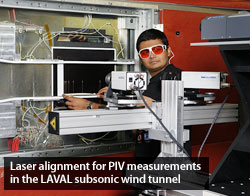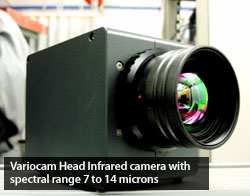
Researches at the Laboratory for Energy Conversion at ETH Zurich use custom infrared optics supplied by Del Mar Photonics in the wind tunnel measurements at high temperatures and highly turbulent flow from the jets.
The ZnSe window with high accuracy antireflective coating enabled an IR
transmittance of more than 92% for our wind tunnel.
The main flow was heated to 120 °C and the coolant jet to -20°C. The wind tunnel
window which allowed infrared access was made of ZnSe provided by Del Mar of
large dimension of 100 x 100 x 10. We managed to test many geometries and
operating conditions even at high temperatures and highly turbulent flow from
the jets.
Specifications for ZnSe window at Laboratory for Energy Conversion at ETH Zurich
request a quote for custom ZnSe window
The Laval test rig consists of a subsonic wind tunnel powered by a centrifugal
compressor, driven by a 470 kW electrical motor. The compressor is taken from an
ABB VTC 254 turbocharger. In the current configuration, the wind tunnel has been
adapted primarily for film cooling experiments.
The Laval wind tunnel can has a rectangular test section of dimensions 40mm x
181 mm x 400 mm. Typical freestream velocities can go up to 160 m/s or a Mach
number of M=0.5, i.e. a mass flow rate of about 1.5 kg/s. A boundary layer based
Reynolds number of 700 000 is thus attainable. The freestream flow can be heated
to a temperature of 120°C by a steam heat exchanger which can be accurately
regulated and controlled. A water-cooled heat exchanger extracts the heat from
the freestream downstream of the test section before it returns in a closed loop
to the compressor. The boundary layer thickness of the flow is controlled by a
suction arrangement. The boundary layer is sucked off through multiple, 1.2 mm
diameter, discrete holes of covering an area of 60 mm x 180 mm. The extracted
air is fed back into the loop downstream.
In order to study mixing and jet impingement a secondary air supply also exists
to provide air which can be cryogenically cooled down to –40°C. This cooled air
can be injected through different hole arrangements to study various jet-in-crossflow
configurations. The different temperatures between the injectant and the
freestream are required to mimic the density ratios typically found in jet
engines. In order to study unsteady effects the cool air can also be pulsated
via an in-house designed pulsator, with frequencies up to 500 Hz.
The wind tunnel walls have access for intrusive probe measurements as well as
for PIV and IR thermography.

Infrared thermography is the state-of-the art in the temperature measurement. It
is a non-intrusive technique that involves visualizing the infrared radiation
from a suitably blackened surface to determine its temperature. The emitted
intensity of infrared radiation has a unique correlation with the surface
temperature.
The infrared thermography system comprises primarily of an IR camera has the
following characteristics.
Request a quote for custom infrared thermography system

Detector Type: uncooled microbolometer FPA detector
Spatial Resolution: 384 x 288 IR-pixels combined with a 25mm lens allowing
smallest resolvable dimension of 20 pixels per mm
Infrared image rate: 50 Hz
Temperature measurement range: -40 to 1200 °C
Thermal resolution: 0.08K
Measurement accuracy: +/- 1.5 K
Optical access is provided by an IR transmitting ZnSe window with
anti-reflective coating, that allows >92% transmittance in the wavelength range
between 7.5 to 14 microns (Del Mar Photonics, Inc.).
request a quote for custom ZnSe window
ETH Zurich is a science and technology university with an outstanding
research record.
ETH Zurich is the study, research and work place of 20,000 people from 80
nations. About 370 professors in 16 departments teach mainly in the engineering
sciences and architecture, system-oriented sciences, mathematics and natural
sciences areas and carry out research that is highly valued worldwide.
As an internationally oriented institution of higher education and a nationally
grounded one this forward-looking task is fulfilled in service to the Swiss
nation.
Twenty-one Nobel Laureates are connected with ETH Zurich. Maintaining and
developing its top standing in the international competition among top
universities is an important task of ETH Zurich.